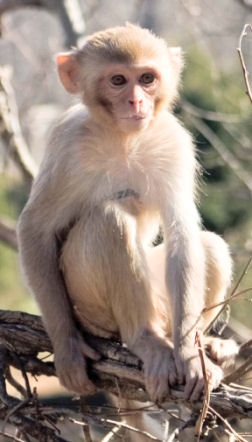Primate’s Progress: Macaque genome is usefully different
A group of 35 labs this week unveiled a draft of the genome for the rhesus macaque, the most widely used laboratory primate and a cousin to people.

“The big question here is, ‘What makes us human?'” says Richard A. Gibbs of the Baylor College of Medicine in Houston, who led the DNA-sequencing project.
The rhesus macaque is the third primate to have its genome described. Scientists reported the detailed human sequence in 2003 (SN: 4/19/03, p. 245: Available to subscribers at Moving On: Now the human genome is really done) and a draft of the chimpanzee genome in 2005 (SN: 9/3/05, p. 147: Chimps to People: Apes show contrasts in genetic makeup). With the macaque, human, and chimpanzee sequences now in hand, researchers can triangulate to learn what genes primates share and what genes are uniquely human. “Just seeing differences in chimpanzees and humans, it’s been hard to say what’s on the chimpanzee side and what’s on the human side,” says Gibbs.
Chimps share 98 percent of their DNA with people. The consortium reports in the April 13 Science that 93 percent of the macaque genome resembles that of people and chimps.
Chimps are so genetically close to people that it’s been difficult to tell whether a similarity indicates a sequence valuable enough to persist through evolutionary history or just a happenstance of a shared family background. The macaque’s extra bit of difference could help scientists make that distinction, says Gibbs.
The macaque also offers a deeper view into primate history. The chimp and human lineages split some 6 million years ago. Rhesus macaques had diverged about 19 million years earlier.
The rhesus macaque (Macaca mulatta) ranges widely across Asia. It’s one of 22 species of macaques, all of which are classified as Old World monkeys.
The draft DNA sequence, which the research consortium deciphered in about 2 years, covers about 98 percent of the macaque’s genome. As in the human and chimp genomes, about half the DNA consists of genetic elements that don’t encode proteins and can insert extra copies of themselves.
In an early comparison of the three available primate genomes, the consortium notes human-specific features. For example, there are additions in one of the human-DNA sequences for keratin, a component of hair.
The new sequence information already indicates that some normal macaque genes look like human versions associated with diseases. For example, macaque versions of several enzyme genes look like ones that cause phenylketonuria, a condition that causes mental retardation in people.
“The macaque-genome sequence will have an important impact on both biomedical research and basic research,” comments Michele Cargill of the company Affymetrix in Santa Clara, Calif. She has compared the chimpanzee and human sequences but wasn’t a member of the macaque consortium.
Cargill predicts that the new genome will advance the study of mechanisms underlying infection and immune responses and will boost progress in vaccine development.
The new genome offers opportunities for testing ideas about gene regulation, says geneticist Alan Baxter of the Comparative Genomics Centre at James Cook University in Townsville, Australia, and not in the consortium. “It is likely that many of the differences between man and the closely related primates lie not so much in gene sequence but in the regulation of the expression of those genes,” says Baxter.